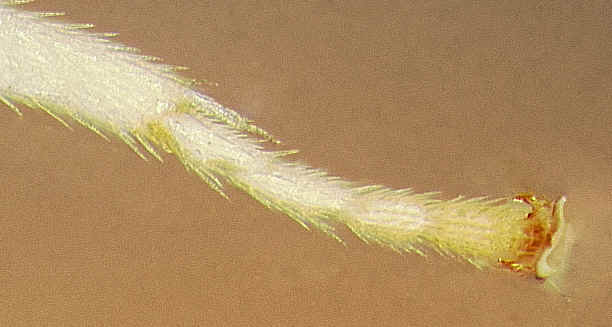1a-b: Eulophus face (left), and mesosomatic dorsum (right)
return to: Eul 1 Eul 4 ent 1 eud 1 cir1 eul 1 eul 5 eul 10 eul 14 eul 17 eul 20 eul 24 eul 27
Eulophus Geoffroy, 1762 comparative info return to: prev home
Body large and stout. Mandibles reduced, not capable of meeting
medially. Flagellar formula 1,3,3 or 1,4,2, always with 4
funicular segments in males; funicular segments with 3 long branches in males of most
species, but unbranched in some; scape sometimes slightly exceeding vertex. Notauli
incomplete or ending in axillae far from scutellar margin; scutellum without submedian
grooves; scutellar setae paired. Postmarginal vein subequal or slightly longer than
stigmal vein (at most 1.7x stigmal vein length). 2 metatibial spurs, neither longer than
1st metatarsal segment; basal mesotarsal segment (sometimes also basal metatarsal
segment) shorter than 2nd segment, subequal or shorter
than mesotibial spur. At least some species with seasonal color morphs. Compare
with: Necremnus, Microlycus, Dahlbominus,
Colpoclypeus.
1a-b: Eulophus face (left), and mesosomatic dorsum (right)
2a-b: Eulophus typical female antenna (left), and E.
thespius Walker male antenna (right, atypical of this genus)

3a-b: Eulophus larvarum (L.) male (left), and mesotarsus
(right)
Biology: Gregarious parasitoids of Lepidoptera, pupation occurring outside host.
Comments: Large genus, probable relative of Necremnus and Microlycus. Specimens are generally large bodied, although this feature can be very misleading if treated as a primary diagnostic character. This is one of the easier genera to identify in the North American fauna.
Comparative information:
Generally similar to Necremnus, Microlycus, Dahlbominus, and Colpoclypeus, but easily distinguished from them all in having mandibles that are not capable of meeting medially, and basal mesotarsomere that is much shorter than the next tarsomere. A few other Eulophines, such as Euplectrini, Hoplocrepis, and Ogmoelachertus, have mandibles incapable of meeting, but these are much different from Eulophus and not easily confused with it.
References
Askew, R.R. 1968. Hymenoptera 2. Chalcidoidea section (b). Handbooks for the Identification of British Insects. 8(2)b.
Boucek, Z. 1959. A study of central European Eulophidae, 1: Eulophinae (Hymenoptera). Acta Entomologica Musei Nationalis Pragae. 33: 117-170.
Image credits: 1a-b: Schauff, et al. (1997). 2a-b: Boucek (1959). 3a: Askew (1968).